Top 10 Quickbase Alternatives and Competitors in 2025
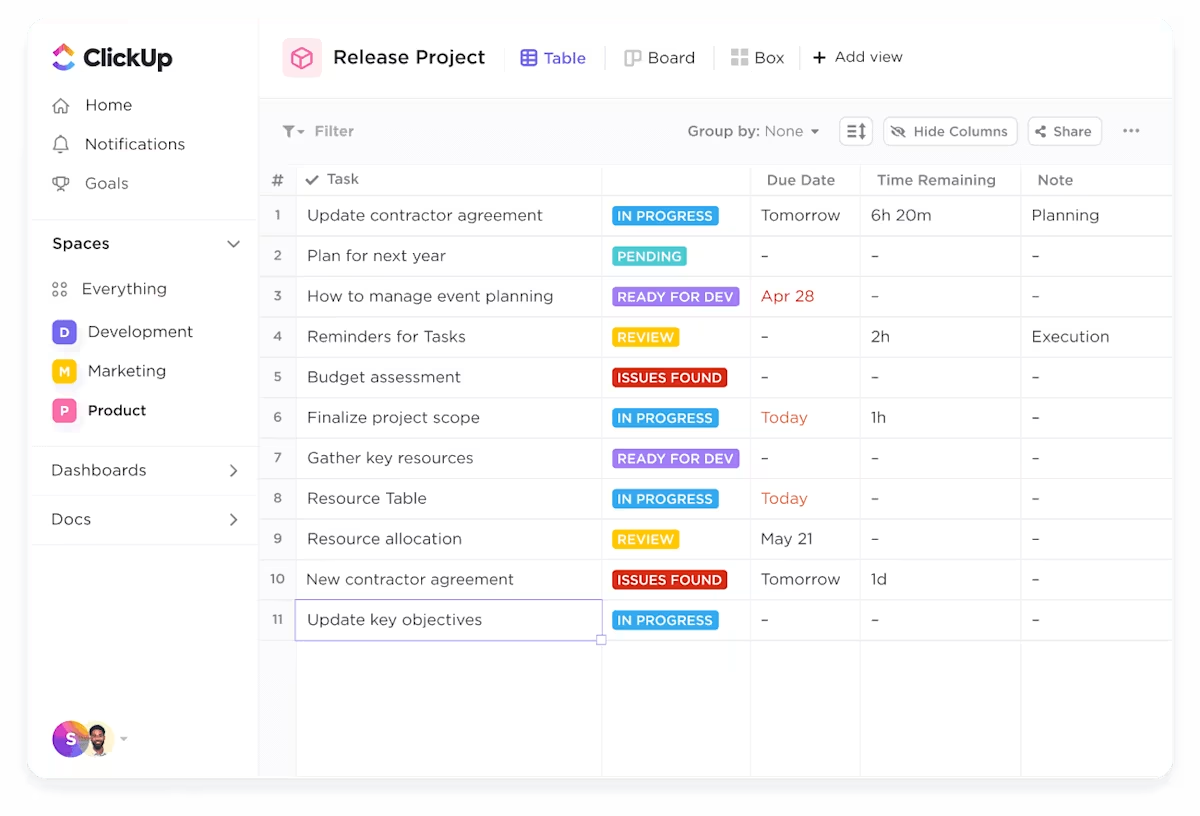
Sorry, there were no results found for “”
Sorry, there were no results found for “”
Sorry, there were no results found for “”

The low-code platform market is booming, and Quickbase is a big name in the game.
But not everyone’s a fan. Maybe the interface feels clunky, the pricing stings, or you just need something with more flexibility. Whatever the case, you’re not stuck with just one application development platform.
There are plenty of great alternatives, from feature-packed powerhouses to budget-friendly picks. So, let’s check out the best Quickbase competitors and find the right platform for your business.
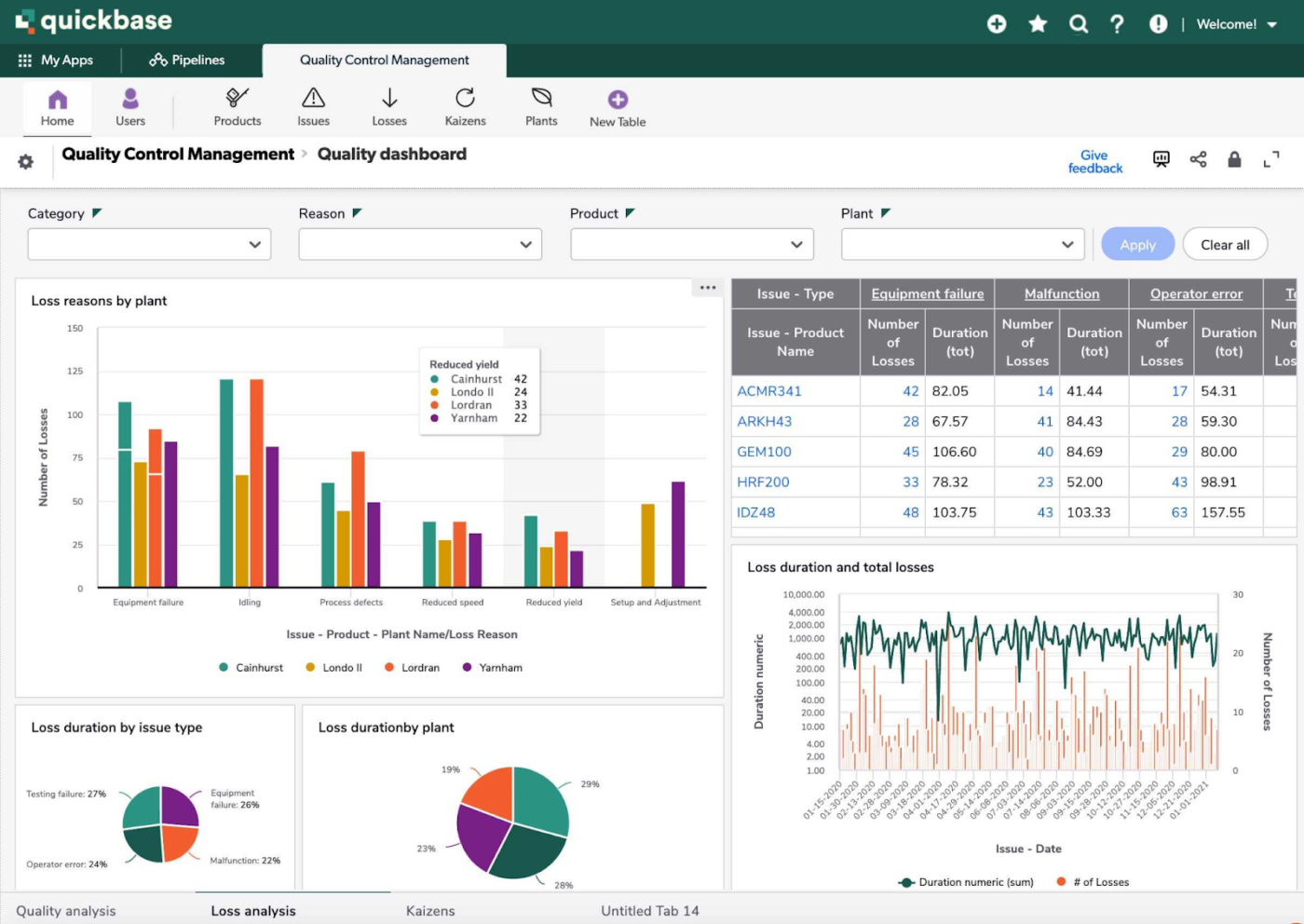
Quickbase is a low-code platform that lets you build custom apps without wrestling with complex code. Whether automating workflows, managing projects, or tackling specific business challenges, you can do it all in a few clicks.
It pulls data from multiple systems, giving you real-time insights in one place, without bouncing between spreadsheets. Automation handles the repetitive work, boosting your team’s efficiency. And its intuitive drag-and-drop builder makes designing custom business applications feel simple.
Always on the move? Quickbase has a mobile app for iOS and Android to keep everyone in sync. Meanwhile, admins can easily manage users, enforce security, and ensure data integrity while teams work smarter with interactive reports and actionable insights.
Quickbase is a solid tool for building custom applications, but it’s not without its drawbacks. Here are some pain points you might bump into:
These hiccups might have you looking around for Quickbase competitors that fit your team’s workflow like a glove.
👀 Did You Know? According to the U.S. Department of Labor and Statistics, software developer jobs will grow 17% in the next decade (much faster than average)!
When picking a Quickbase alternative, focus on your goals.
Are you building simple workflows or need a platform that can handle complex business processes? Are you looking for easy customization, or is security your top priority?
Whatever your needs, here are the key factors to keep in mind:
| Tool name | Key features | Best for | Pricing |
| ClickUp | Project & task management, custom workflows, low-code automations, AI Agents, 15+ views, Table View, templates, time tracking, 1,000+ integrations | Project management & custom workflows | Free; paid plans start at $7/user/month |
| Airtable | Spreadsheet-database hybrid, custom fields, linked tables, automation, multiple views, integrations, mobile app | Creating & managing custom databases | Free; Paid plans start at $20/user/month |
| Zoho Creator | Low-code app builder, Zia AI, BI analytics, payment integrations, REST APIs, 99.9% uptime | Low-code app building & workflow automation | Starts at $12/user/month |
| Smartsheet | Spreadsheet-style interface, Grid/Card/Gantt/Calendar views, workflow automation, DataMesh, Brandfolder, CMEK security | Project management with spreadsheets | Free; Paid plans start at $12/user/month |
| Appian | Process orchestration, RPA, AI, data fabric, dynamic reporting, mobile-ready apps, case management | Automating complex business processes | Custom pricing |
| Mendix Platform | Advanced IDE, AI assistant, composable architecture, prebuilt integrations, rapid deployment | Rapid app development & process automation | Free; Starts at $1,027+/month |
| Caspio | No-code app builder, AI assistant, REST API, SQL functions, payment integrations, FileStor CDN | Small businesses building custom database apps | Starts at $100/month |
| Oracle APEX | Low-code web app builder, interactive reports, AI assistant, REST data, PWA support, localization | Enterprise-grade apps with Oracle Cloud | Always free; Paid plans start at $122/month |
| Monday.com | Customizable workflows, automation recipes, 200+ integrations, Apps Framework, real-time analytics, AI tools | Creating customizable workflows | Free; Paid plans start at $12/seat/month |
| Kintone | Custom apps, 25+ data field types, granular permissions, workflow automation, charts, revision history | Custom apps & workflows for small businesses | Starts at $16/user/month |
Our editorial team follows a transparent, research-backed, and vendor-neutral process, so you can trust that our recommendations are based on real product value.
Here’s a detailed rundown of how we review software at ClickUp.
Ready for a change? These 10 Quickbase alternatives can help you create custom apps without the hassle of coding:

If you’re looking for a Quickbase alternative that offers task management, custom workflows, and no-code automations, ClickUp might be your perfect match. It’s built for teams who want powerful low-code tools without the headache of traditional database platforms.
Where ClickUp really shines is in its low-code Automations and AI-powered Agents. With Automations, you can set up custom rules that automatically assign tasks, update statuses, or send notifications—no code required.
The visual automation builder makes it easy for anyone to streamline processes and eliminate repetitive work. But that’s not all: ClickUp’s AI Agents, available in Lists and ClickUp Chat, take automation to the next level. These intelligent assistants can handle routine tasks, answer questions, and even help manage projects for you, freeing up your team to focus on what matters most.
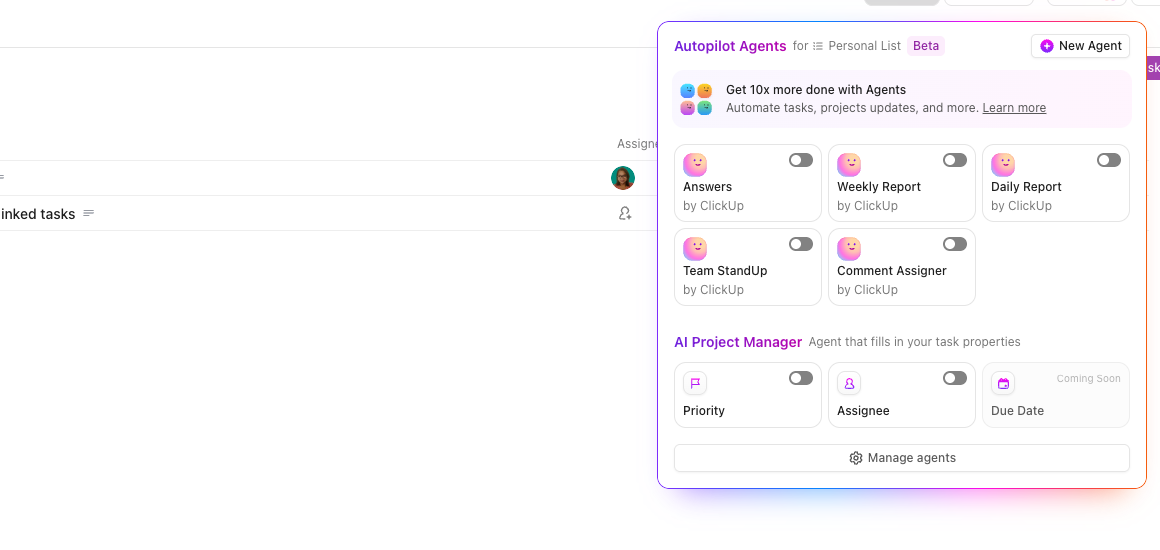
Best part, all of this is deeply integrated with ClickUp Tasks. You can create tasks with rich details, Custom Fields, dependencies, and checklists, ensuring that every aspect of a project is tracked and managed efficiently. The platform supports advanced filtering, sorting, and grouping, allowing teams to tailor their workspace to fit unique processes and reporting needs.
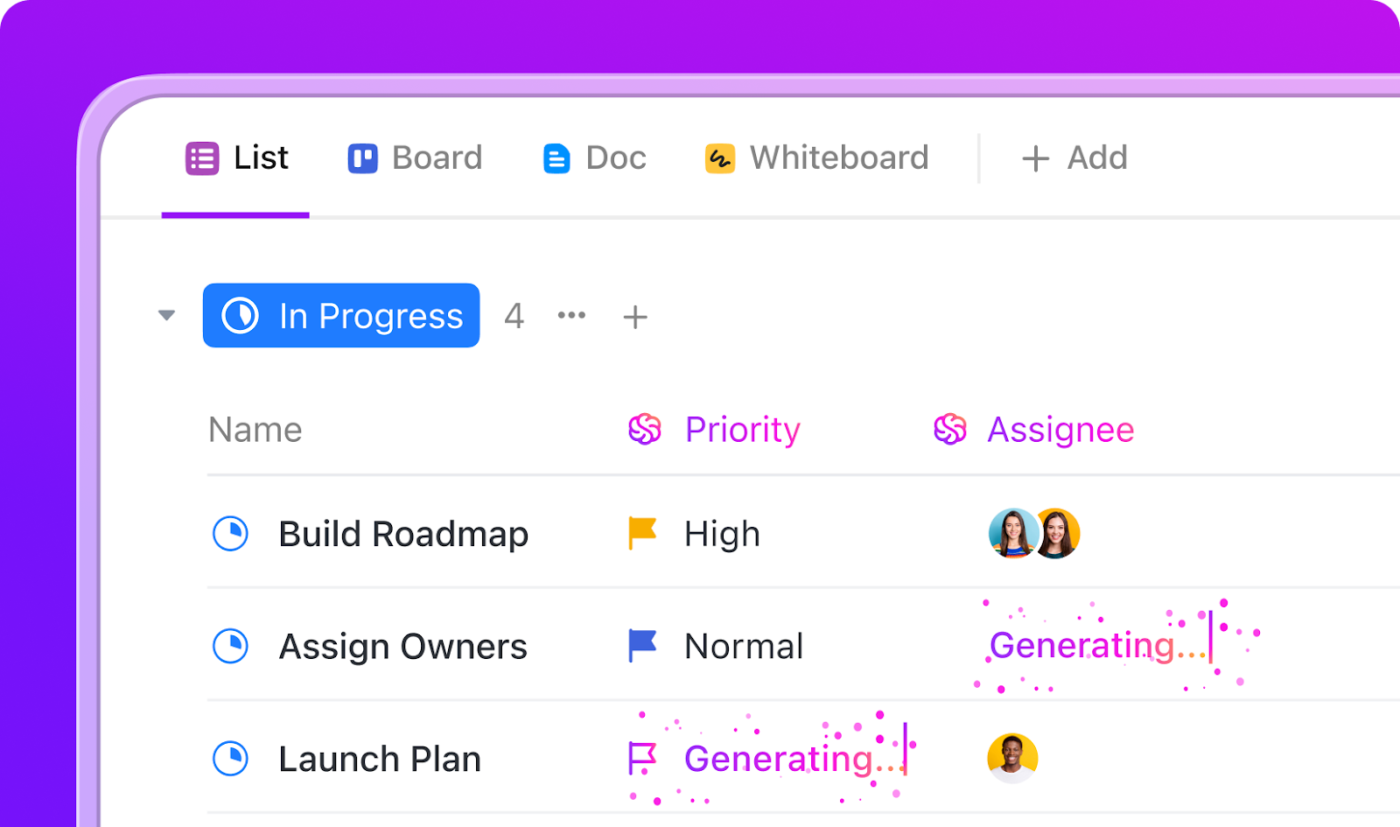
Further, ClickUp’s AI-powered Project Management takes things a step further, giving you complete control over how you plan, track, and execute work. Prefer Gantt charts for timelines? Need Workload View to balance resources? Want a simple Kanban board? You’ve got options—15+ ways to visualize your projects, to be exact.
If organizing data is a priority, ClickUp’s Table View turns ClickUp into a custom database—great for CRMs or tracking anything else your team needs. And with ready-made templates, setup is quick, so you can focus on work instead of formatting.
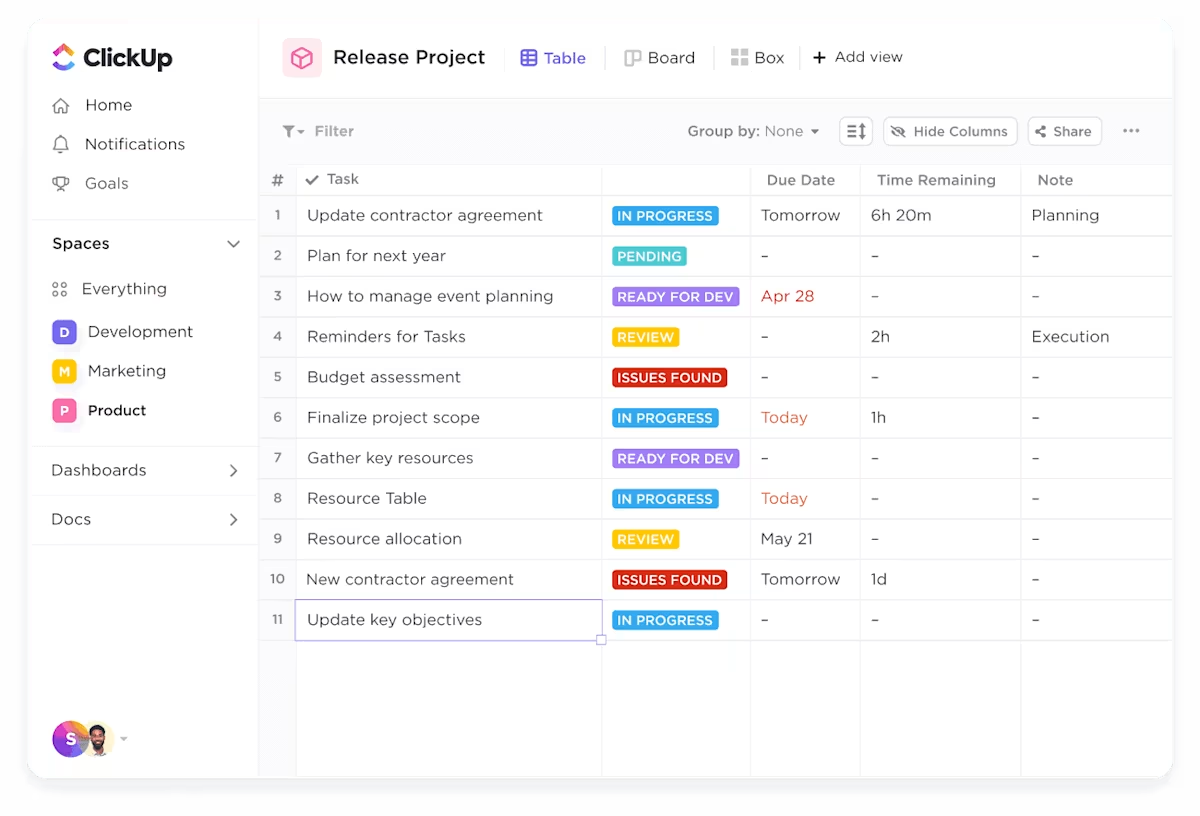
Collaboration is effortless, too. In-app comments, file sharing, and mentions contextualize discussions, while communication plan templates help you get started in minutes. And with Slack and Google Workspace integrations, ensure everything stays connected.
And, of course, there’s ClickUp Project Time Tracking—because knowing where your team’s hours are going is just as important as managing the work itself. Generate reports, identify bottlenecks, and keep workflows running smoothly, so every minute is well spent.
A G2 review reads:
I love ClickUp and the way it can automate processes, from changing ownership based on a task status to tracking the amount of time users spend on a task. It’s been a great tool to collaborate across projects that require multiple people, including third-parties.
📮ClickUp Insight: 88% of our survey respondents use AI for their personal tasks, yet over 50% shy away from using it at work. The three main barriers? Lack of seamless integration, knowledge gaps, or security concerns.
But what if AI is built into your workspace and is already secure? ClickUp Brain, ClickUp’s built-in AI assistant, makes this a reality. It understands prompts in plain language, solving all three AI adoption concerns while connecting your chat, tasks, docs, and knowledge across the workspace. Find answers and insights with a single click!
➡️ Also Read: How to Choose a CRM System for Your Business
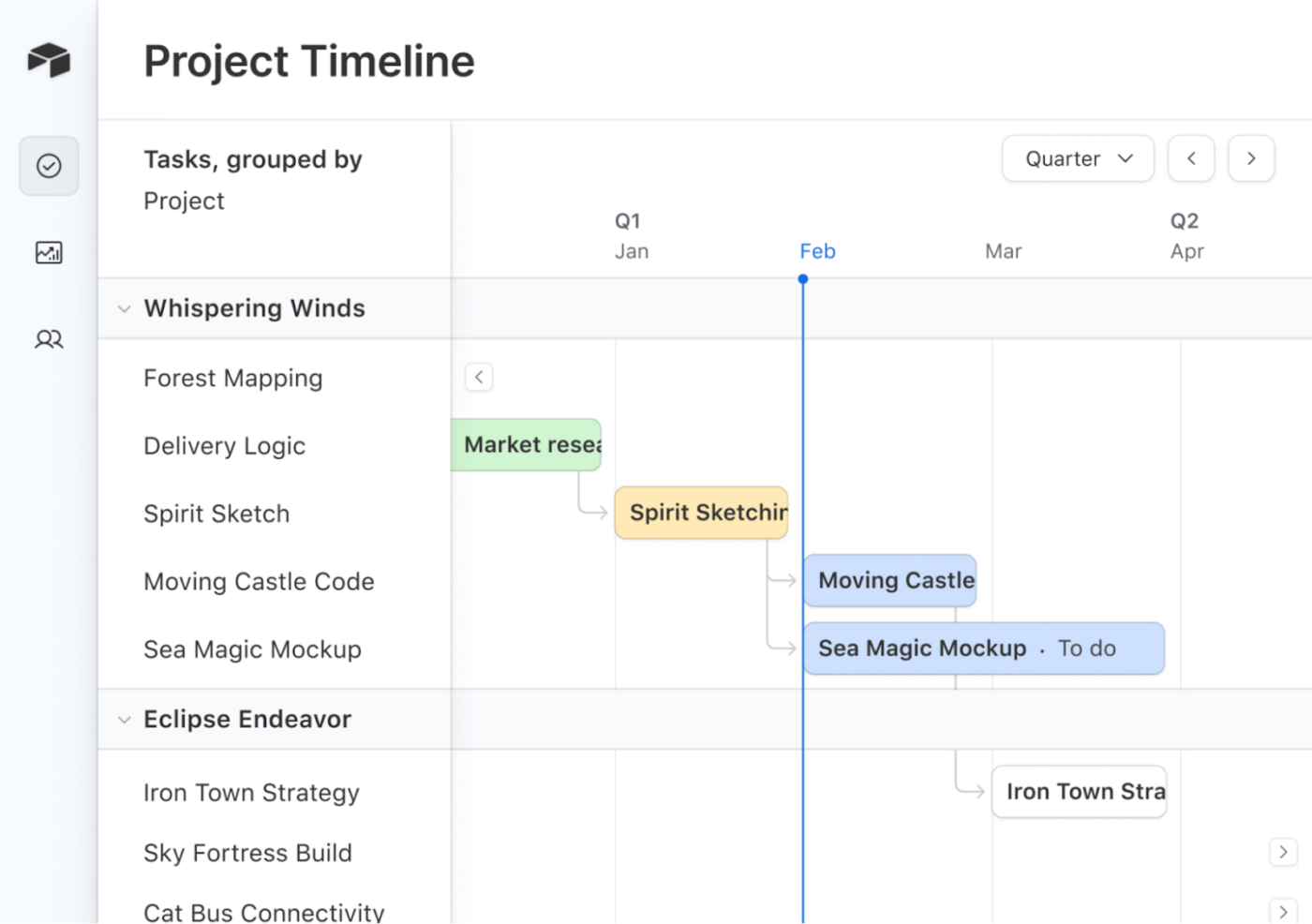
As a web-based SaaS platform, Airtable makes it easy to build databases from scratch, customize fields, link tables, and automate processes. It blends the ease of a spreadsheet with the strength of a database, making it a strong Quickbase alternative.
With customizable fields, linked tables, and automation, it improves workflows without complexity. Whether you’re handling projects, sales pipelines, or content calendars, this database software keeps everything structured, accessible, and easy to manage—no extensive coding knowledge required.
A G2 review says:
Airtable’s flexibility is its biggest strength. We’ve used it for everything from tracking client projects to automating tasks. One standout example was when we set up a custom Stripe integration for a client using Airtable’s scripting and webhook features—it worked perfectly and saved us a lot of time.
➡️ Also Read: Best Airtable Alternatives
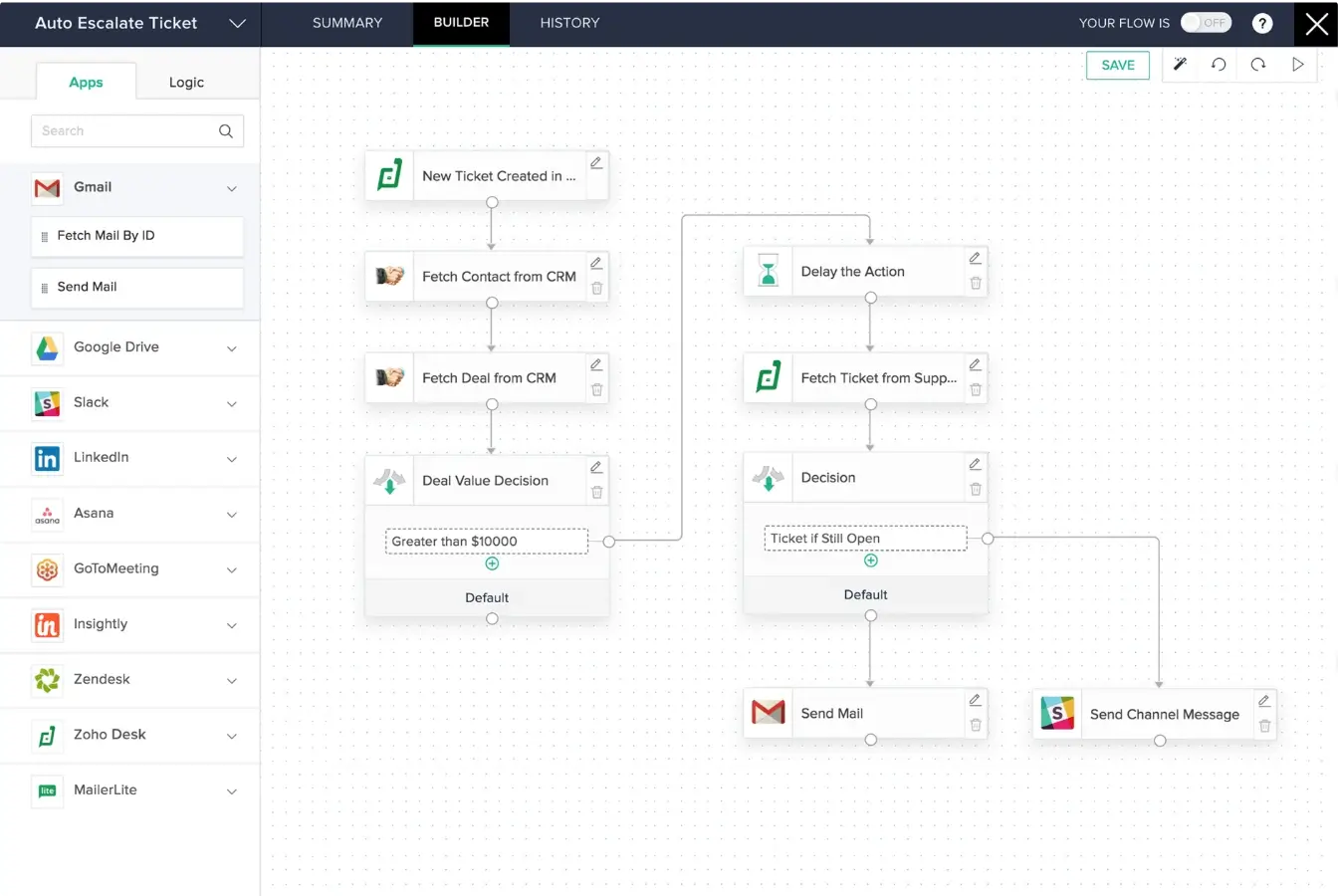
What if your low-code app could do more than just follow orders? Zoho Creator’s Zia AI brings smart predictions, sentiment analysis, and data insights straight into your workflows, so your apps don’t just run—they learn.
Built-in payment integrations like PayPal and Razorpay handle transactions seamlessly; no extra tools needed. That’s one edge over Quickbase, which relies on payment integrations via Zapier or Pipedream.
A G2 review says:
The best part of Zoho Creator is its no-code platform, which allows us to create applications for our businesses based on our needs without having to write fixed lines of code. It is also an easy way to get data from forms and make graphs from them, as if you had several forms that were linked together and you could extract information from all of them.
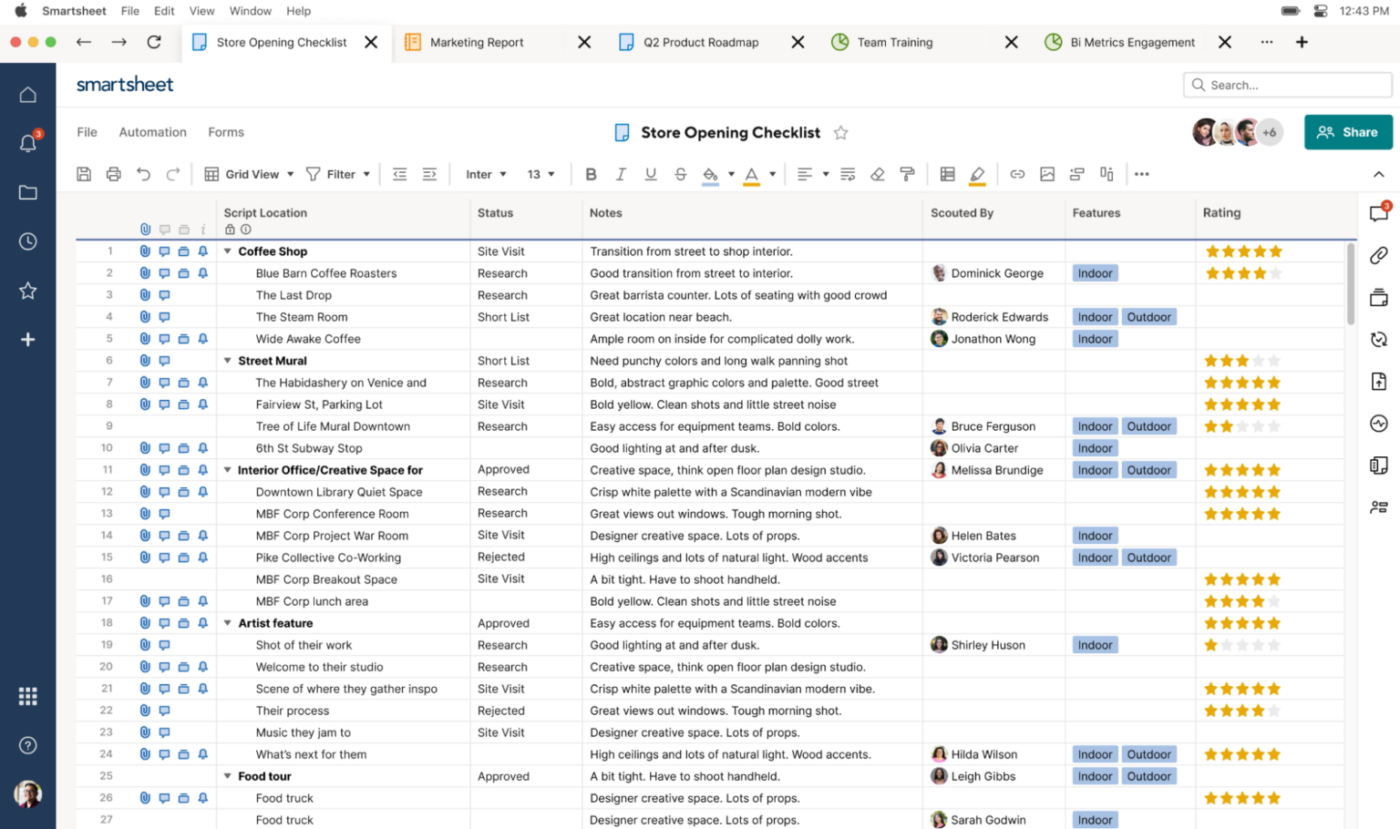
Smartsheet offers an intuitive spreadsheet-style interface with Grid, Card, Gantt, and Calendar views built right in—no extra setup needed. Critical path tracking helps teams instantly identify bottlenecks, a native feature that Quickbase lacks.
Smartsheet also simplifies workflow automation with no-code rules for alerts, approvals, and task assignments, keeping processes moving without manual effort. This makes it a structured, visual, and easy-to-use alternative to Quickbase’s more database-heavy approach, especially for teams juggling multiple projects.
A G2 review says:
I like how Smartsheet is versatile and can be utilised for many different applications. Sometime I just use it as a more advanced and interactive version of Excel, other times you can take advantage of its dashboard and automation functionalities to create very powerful tools that can make work a lot easier and more organized.
➡️ Also Read: Free Spreadsheet Templates in Excel & ClickUp
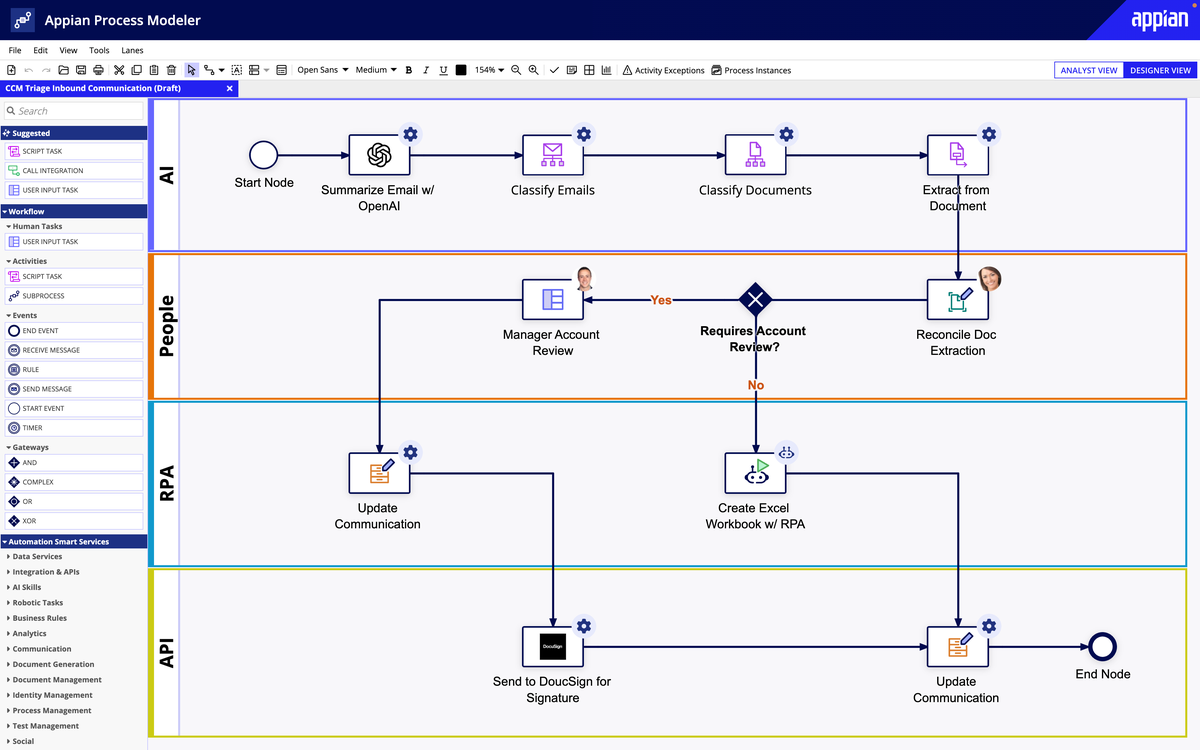
Appian stands out with process orchestration, ensuring seamless coordination between human tasks and digital automation. Its drag-and-drop interface makes building enterprise applications easy, while data fabric technology unifies data from multiple sources without complex coding.
The tool also excels in AI-powered document processing and advanced case management, making it a strong choice for organizations handling complex workflows. With built-in automation for approvals, task assignments, and integrations with major enterprise tools, it streamlines operations while keeping everything connected.
A Capterra review says:
It’s easy to set up integrations with 3rd party systems, prebuilt standard layouts and UI components & powerful process model capabilities are excellent.
👀 Did You Know? Accenture predicts AI could support or augment 40% of working hours! In low-code custom app development, that means faster workflows, smarter automation, and less manual work.
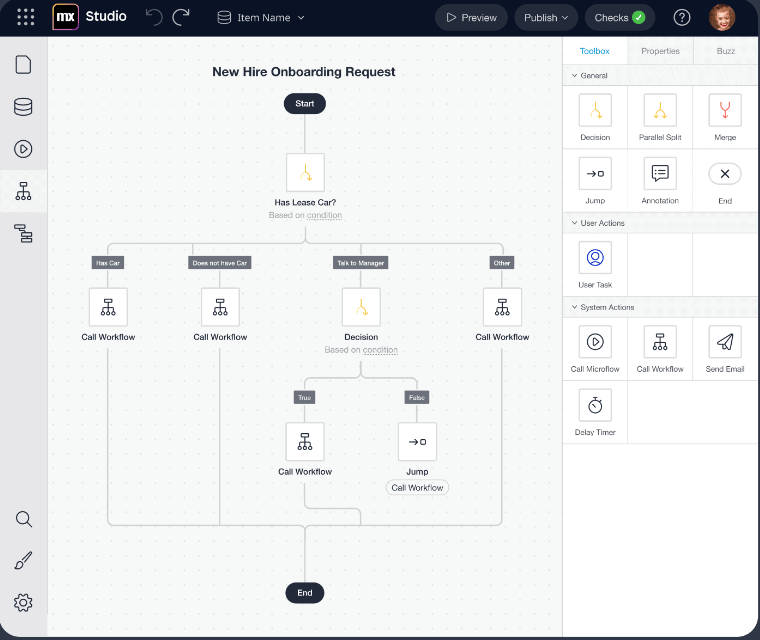
Generative AI and other technologies can automate 60 to 70% of work activities, reducing repetitive tasks like data entry and file organization. Mendix takes this further with Maia, its AI assistant, which suggests microflows, widgets, and logic components to speed up development.
Its composable architecture ensures modularity, allowing teams to quickly assemble and reuse application components, making it easier to adapt to evolving business needs.
A G2 review says:
Mendix is a great low-code and no code platform which has the great potential to enable rapid application development model within the business.
The best part what I like about Mendix is TAT(Turn around time) of the project. With help of Mendix, we can easily deliver an application in a span of 3 weeks from scratch right from development to deployment which usually takes months in case of traditional coding.
🧠 Fun Fact: The roots of low-code development trace back to the 1980s and 1990s with the emergence of rapid application development (RAD) tools like Borland’s Delphi, PowerBuilder, and Microsoft’s Visual Basic.
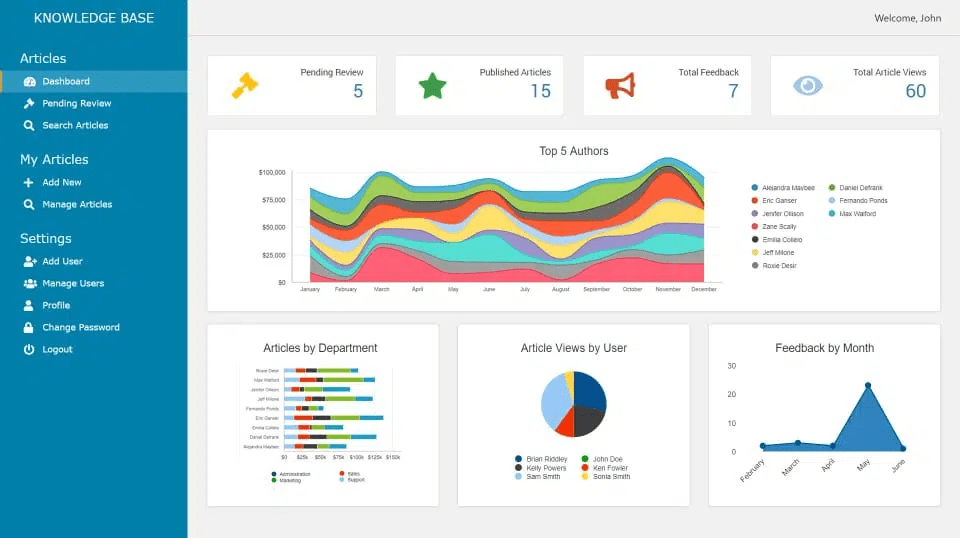
Caspio delivers a true no-code experience, making it easy for non-technical users to build online database applications. Where it outshines Quickbase is in automation—think database triggers, scheduled tasks, and webhooks that keep data flowing in real time without lifting a finger.
And when it comes to integrations, Caspio’s native REST API eliminates the need for tedious workarounds that Quickbase users often face.
A Capterra review says:
The Caspio platform was easy to use, and I was able to get an application started within a week of learning the software. Their customer service is great and very willing to help with any issues I had.
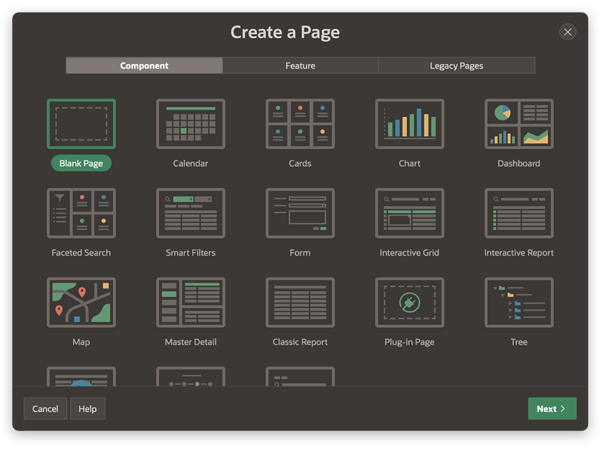
Oracle APEX is a low-code platform designed for building web applications that are secure and scalable, with minimal coding. One of its standout features is Interactive Reports, allowing users to filter, search, sort, and customize data views to suit their needs.
The platform also incorporates AI-driven capabilities, including the APEX AI Assistant, which helps developers generate, optimize, and debug SQL queries and refine HTML, JavaScript, and PL/SQL.
A Capterra review says:
My favourite features are turning spreadsheets into apps, external data sharing, and the ability to scale and deploy apps either on the cloud or on-premises.

Unlike Quickbase, which requires coding for advanced customization, Monday.com’s Apps Framework enables users to build custom apps, dashboards, and integrations with little to no code.
Its automation recipes handle repetitive tasks, reducing the need for scripting, while 200+ native integrations connect seamlessly with tools like Slack, Google Workspace, and Salesforce.
A G2 review says:
Some features require advanced setup to work efficiently—like dependencies or complex automations—which can slow down onboarding new collaborators. Also, the mobile app isn’t as smooth when it comes to handling large boards or high-volume updates, which limits flexibility on the go.
🧠 Fun Fact: Forrester Research first introduced the term “low-code development” in a 2011 report discussing new productivity platforms for custom applications.
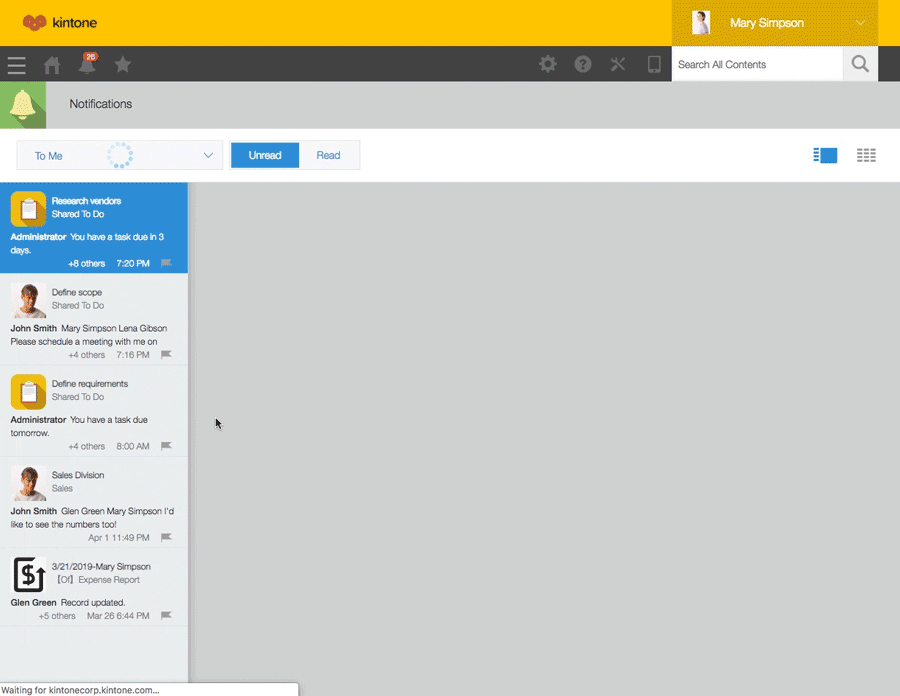
Kintone keeps all communication within your workflows, ensuring nothing gets lost in the shuffle.
Another big win? Its granular permission settings. Admins can control access at the field, record, and app levels—going beyond Quickbase’s role-based permissions. Need to hide specific fields or adjust visibility based on conditions? Kintone makes it easy, giving teams more flexibility in managing sensitive data while keeping collaboration seamless.
A G2 review says:
We needed to move our forecasting and pricing system out of excel into a database format. I love that we have all the functionality of excel with all the permissions and flexibility of a database. We were able to implement a fully functioning system in a fraction of the time and still have all the flexibility that we loved from excel. The migration went very well, and setup was a breeze. I have told several industry friends that they should look into Kintone. We use it everyday with our entire team and we integrate it into our domo system for reporting.
Quickbase is great for custom applications, but it might be time for a switch if its limitations—pricing, integration gaps, or a steep learning curve—are holding you back.
The right alternative should fit your workflow, scale with your business, and offer flexibility without rigid structures.
ClickUp blends project management with customizable workflows, automation, and real-time collaboration. Build no-code workflows, track projects from start to finish, and keep your team aligned—all in one place.
Looking for a flexible, all-in-one solution? Sign up for ClickUp for free.
© 2025 ClickUp